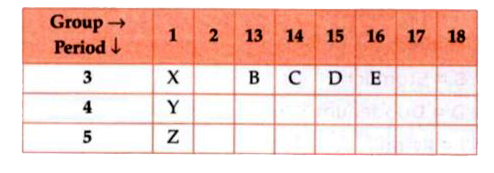Electronic configuration of few elements are given below. Mark the incorrect match.
1s22s22p5, Most electronegative element
1s22s22p3, An element, belonging to 3 period and 5 group
1s22s22p63s23p63d84s2, A d - block element
1s22s22p63s23p6, An element from 18 group
The correct Answer is:B
To solve the question of identifying the incorrect match among the electronic configurations provided, we will analyze each option step by step.
1. Identify the Electronic Configurations:
- We need to analyze the electronic configurations given in each option and determine the corresponding element and its group and period.
2. Analyze Option 1:
- Electronic Configuration: 1s² 2s² 2p⁵
- Total Electrons: 2 + 2 + 5 = 9
- Element: The element with atomic number 9 is Fluorine (F).
- Group: 17 (Group of Halogens)
- Period: 2
- Conclusion: This match is correct.
3. Analyze Option 2:
- Electronic Configuration: 1s² 2s² 2p³
- Total Electrons: 2 + 2 + 3 = 7
- Element: The element with atomic number 7 is Nitrogen (N).
- Group: 15 (Group of Pnictogens)
- Period: 2
- Conclusion: This match is correct.
4. Analyze Option 3:
- Electronic Configuration: 1s² 2s² 2p⁶ 3s² 3p⁶
- Total Electrons: 2 + 2 + 6 + 2 + 6 = 18
- Element: The element with atomic number 18 is Argon (Ar).
- Group: 18 (Noble Gases)
- Period: 3
- Conclusion: This match is correct.
5. Analyze Option 4:
- Electronic Configuration: 1s² 2s² 2p⁶ 3s² 3p¹
- Total Electrons: 2 + 2 + 6 + 2 + 1 = 13
- Element: The element with atomic number 13 is Aluminum (Al).
- Group: 13 (Group of Boron)
- Period: 3
- Conclusion: This match is incorrect as it states it belongs to the 5th group, but it actually belongs to the 13th group.
Final Answer:
The incorrect match is Option 4.
- We need to analyze the electronic configurations given in each option and determine the corresponding element and its group and period.
- Electronic Configuration: 1s² 2s² 2p⁵
- Total Electrons: 2 + 2 + 5 = 9
- Element: The element with atomic number 9 is Fluorine (F).
- Group: 17 (Group of Halogens)
- Period: 2
- Conclusion: This match is correct.
- Electronic Configuration: 1s² 2s² 2p³
- Total Electrons: 2 + 2 + 3 = 7
- Element: The element with atomic number 7 is Nitrogen (N).
- Group: 15 (Group of Pnictogens)
- Period: 2
- Conclusion: This match is correct.
- Electronic Configuration: 1s² 2s² 2p⁶ 3s² 3p⁶
- Total Electrons: 2 + 2 + 6 + 2 + 6 = 18
- Element: The element with atomic number 18 is Argon (Ar).
- Group: 18 (Noble Gases)
- Period: 3
- Conclusion: This match is correct.
- Electronic Configuration: 1s² 2s² 2p⁶ 3s² 3p¹
- Total Electrons: 2 + 2 + 6 + 2 + 1 = 13
- Element: The element with atomic number 13 is Aluminum (Al).
- Group: 13 (Group of Boron)
- Period: 3
- Conclusion: This match is incorrect as it states it belongs to the 5th group, but it actually belongs to the 13th group.
The incorrect match is Option 4.
Topper's Solved these Questions
Similar Questions
Knowledge Check
Electron configurations of few elements are given below,Mark the incorrect match.
A1s22s22p5 -Most electronegative elementB1s22s(2)2p3-An element belonging to 3rd period and 5th groupC1s22s22p63s23p63d84s2-A d-block elementD1s22s22p63s23p6-An element from 18th groupMark incorrect match.
AHormone categoryCharacteristic(1)Cortisol steroidAnti inflammatoryBHormone categoryCharacteristic(2)FSH glycoproteinSecond messenger is cAMPCHormone categoryCharacteristic(3)Thyroxine phenolicWater- soluble hormoneDHormone categoryCharacteristic(4)EstrogenLipid soluble
Write electronic configuration of element E.A2,8,3B2,8,6C2,8,5D2,8
Electronic configuration of four elements A,B,C and D are given below
View SolutionThe electronic configurations of some elements are given below. Which of these belong to s block of the periodic table?
View SolutionElectronic configurations of four elements A, B, C and D are given below
View SolutionThe electronic configuration of four elements are given below. Which element does not belong to the same family as others ?
View SolutionThe electronic configuration of four elements are given below. Which elements does not belong to the same family as others?
View Solution